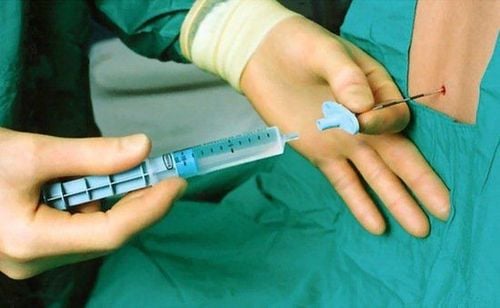This is an automatically translated article.
Duratocin is used in the prevention of uterine atony and postpartum hemorrhage after elective cesarean section under anesthesia. The following is information about Duratocin's uses, dosage and precautions when using Duratocin.
1. What is Duratocin?
What is Duratocin? Duratocin drug has the main ingredient Carbetocin 100mg, is prepared in the form of an intravenous solution, the donation specification is a box of 5 ampoules of 1ml. Duratocin is indicated for the prevention of uterine atony and postpartum hemorrhage following elective cesarean section under epidural or spinal anesthesia.
Duratocin has not been studied in cases of emergency cesarean section, classical cesarean section with anesthesia other than epidural or spinal anaesthesia. In patients with notable cardiac disease, history of hypertension, known coagulopathy, or manifestations of liver, renal, or endocrine disease (except gestational diabetes). Appropriate studies and doses have not been established in women who have given birth vaginally.
2. Dosage and how to use Duratocin
2.1. A single dose of 1 ml DURATOCIN is administered by slow intravenous injection over 1 minute, only after delivery of the baby has been completed by cesarean section under epidural or spinal anaesthesia. DURATOCIN should be administered postpartum as soon as possible, preferably before the placenta.
2.2. How to use Duratocin is administered intravenously.
3. Note when using the drug Duratocin
3.1. Contraindications Due to its longer duration of action than oxytocin and the inability to stop uterine contractions caused by carbetocin simply by discontinuing the drug. Therefore, carbetocin should not be used before delivery for any reason, including induced labor or drug induction. Improper use of carbetocin during pregnancy could theoretically produce oxytocin-like symptoms including: overstimulation of the uterus with strong (hypertonic) or prolonged (spasmodic) contractions. severe labor, uterine rupture, cervical and vaginal tearing, postpartum hemorrhage, uteroplacental hypoperfusion, fetal bradycardia, fetal hypoxemia, hypercapnia or death. Carbetocin should not be used in patients with a history of hypersensitivity to oxytocin or carbetocin. Carbetocin must not be used in patients with vascular disease, especially coronary artery disease, unless extremely cautious. Do not give carbetocin to children. Contraindicated in patients with liver and kidney disease, eclampsia and pre-eclampsia, epileptic patients. 3.2. Side Effects When administered after cesarean section under epidural or spinal anaesthesia, the adverse events observed with carbetocin in clinical trials were of the same type and frequency as those observed with carbetocin. side effects with oxytocin. Intravenous carbetocin is commonly associated (10-40% of patients) with nausea, abdominal pain, pruritus, flushing, vomiting, sensation of heat, hypotension, headache, and tremor.
Uncommon side effects (1-5% of patients) include back pain, dizziness, metallic taste in the mouth, anemia, sweating, chest pain, shortness of breath, chills, tachycardia, and anxiety europe.
3.3. General Precautions for use:
Contraindicated to use DURATOCIN during pregnancy, before the birth of the child; See WARNING for possible additional oxytocin therapy; DURATOCIN is not recommended for elderly patients. For pregnant women: It is necessary to use as prescribed and under the supervision of a doctor; For women who are breastfeeding: The drug is not used for this object; There are no data on the ability to drive or use machines. 3.4. Drug interactions No specific drug interactions with carbetocin have been reported. However, since carbetocin is closely related structurally to oxytocin, it is likely that some similar drug interactions may occur. Severe hypertension has been reported with oxytocin administration 3-4 hours after prophylactic administration of a vasopressor along with a sacral blocking anesthetic. Anesthesia with cyclopropane may alter the cardiovascular effects of oxytocin, producing undesirable results such as hypotension. Maternal sinus bradycardia with abnormal atrioventricular rhythms has been reported when oxytocin was co-administered with the anesthetic cyclopropane.
Duratocin is used in the prevention of uterine atony and postpartum hemorrhage after elective cesarean section under anesthesia. To ensure effective treatment and avoid unwanted side effects, patients need to strictly follow the instructions of the doctor and medical staff.
Follow Vinmec International General Hospital website to get more health, nutrition and beauty information to protect the health of yourself and your loved ones in your family.
Please dial HOTLINE for more information or register for an appointment HERE. Download MyVinmec app to make appointments faster and to manage your bookings easily.













